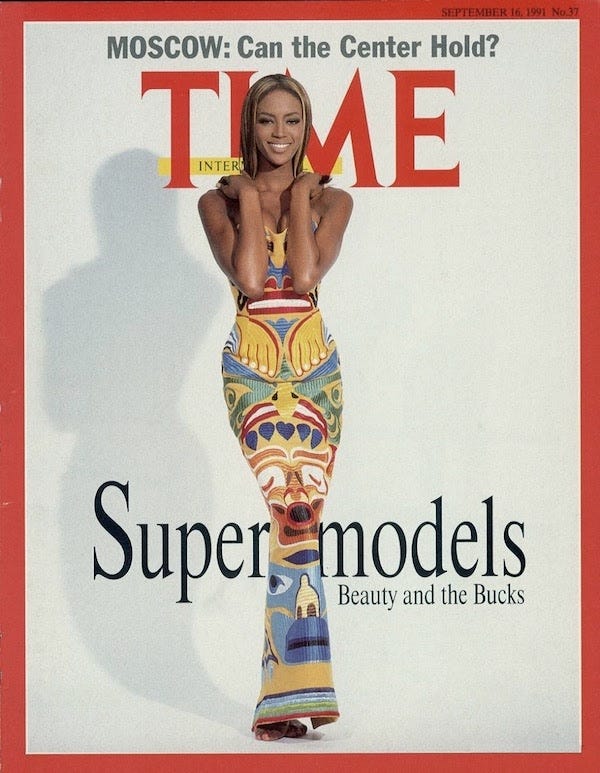'The Super Models' Swung Big — But Did They Knock It Out of the Park?
The new Apple TV+ miniseries seizes on the opportunity to go wide, even when it sacrifices depth in its storytelling.
In the same year that communism collapsed, Naomi Campbell graced the September 1991 cover of Time Magazine. “Moscow: Can the Center Hold?” reads the text above the magazine’s letterhead. Below, outfitted in an Isaac Mizrahi Totem Pole gown, stands the statuesque Naomi, hands on her shoulders, with an accompanying headline that reads: “Supermodels: Beauty and the Bucks.”
In contrast to today’s fame, available en masse but often futile, hollow and unprofitable, fame back then held a power that simply doesn’t exist today — particularly the fame unlocked by the Supers. “Mannequins with sex appeal,” as they were flippantly referred to, were able to translate their fame into lucrative businesses not just for themselves, but for anyone they attached their faces to as well. Today we’d call it branding, and in many ways, these are the foremothers of the branding craft. “We realize the power we have,” a 22-year-old Christy Turlington told Time. “We're making tons and tons of money for these companies, and we know it."
As Vivienne Westwood, may she rest in peace, explained, “I would give [the Supers] everything I could afford because there’s nothing like them for selling the clothes.”
But it was more than just fashion. “These models took tropes about women and rather than be victims of them, they made them icons,” Isaac Mizrahi declares. “It was like ‘high heels… are power.’ Whereas if you talk to Gloria Steinem, [she’d say] ‘You can’t run in high heels.’ And she’s right. She’s right! But we’re right, too. I mean, high heels are beautiful. And they make you look beautiful. And that’s a kind of empowerment.”
This is just one of the many quotables from The Super Models, the endlessly intriguing, even if at times jejune, new Apple TV+ miniseries that seeks to explore the legacy of four of the biggest there ever were: Linda Evangelista, Cindy Crawford, Naomi Campbell, and Christy Turlington.
Their stories, told with completeness for the first time by them and those around them at the heights of their stardom, is explored in four parts: The Look, The Fame, The Power and The Legacy.
Originally announced in October 2020, the highly-anticipated series has a tall order in telling four disparate stories that, despite bisecting from time to time, particularly in 1990 with the one-two punch of George Michael’s “Freedom! ‘90” music video and the subsequent Versace runway show, are really quite singular.
The Super Models has to tell the story of fashion (both as an industry and a cultural intrigue), some important figures in the world whose roles are critical in the lives of these women, and help situate (or resituate, depending on your vantage point) the moment: advertiser woes, rabid consumerism, a decline in the glamor of Hollywood, etc. Plus, the documentary has to navigate the general lack of respect (and often voice) the Supers were afforded in being recognized as some of the savviest business people of their time. All that, and their feelings and perspectives through their lived experience both at the time and their reflections some thirty plus years later. It’s a lot! Add ten executive producers to the mix, including the four women at the center plus head producers Ron Howard and Brian Grazer, and you get a lot of storytelling crammed into a limited amount of space.
Did I enjoy it (said in the same intonation as “Am I a Nicki fan?”)? Start to finish: Yes. Come for the dolls, stay for the archival footage — which is unmatched. Eileen Ford, Karl Lagerfeld, Anna Wintour, Yves Saint Laurent, Valentino Garavani, André Leon Talley — these are just a few of the voices lifted from the past to help tell the story from archival interviews, many of which took place backstage at the shows these women helped make global events. As Amy Odell noted in her review: “The tremendous assemblage of vintage fashion photography shown throughout the four episodes will make anyone who ever read a paper magazine long for the days when image-making was a serious craft instead of something so casual that the barriers to entry now are simply a smartphone and the will to self-promote.”
Then there are the interviews done for the doc. There’s a parade of design legends: Michael Kors, John Galliano, Anna Sui, Vivienne Westwood, Donna Karan, Kim Jones, Isaac Mizrahi, Todd Oldham and Marc Jacobs. There’s photographers (Arthur Elgort and Martin Brading), critics/journalists (Suzy Menkes, Tonne Goodman, Robin Givhan, Jeanne Beker), and creative directors (Fabien Baron, Grace Coddington, Charles Decaro), as well as other fashion notables like Edward Enninful, Bethann Hardison and the delightful Carlyne Cerf de Dudzeele. The series is exploding with source material, both in archival footage and from those who lived it, and seizes on the opportunity to go wide, even when it sacrifices depth in its storytelling.
It’s my understanding that a great documentary seeks to excavate unexplored territory within someone’s life or correct the record on someone’s story. This documentary doesn’t do too much of that, but also doesn't appear incredibly interested in that endeavor. Instead, it seeks to celebrate a time that is largely lost within the zeitgeist due to reaching its apex in the years right before the internet took hold. This series is able to conjure and capture magnificent blips that, while not evoking a sense of completeness or catharsis, are able to unlock a world that is truly mythical and alluring, both then and now. Let’s dig in.












